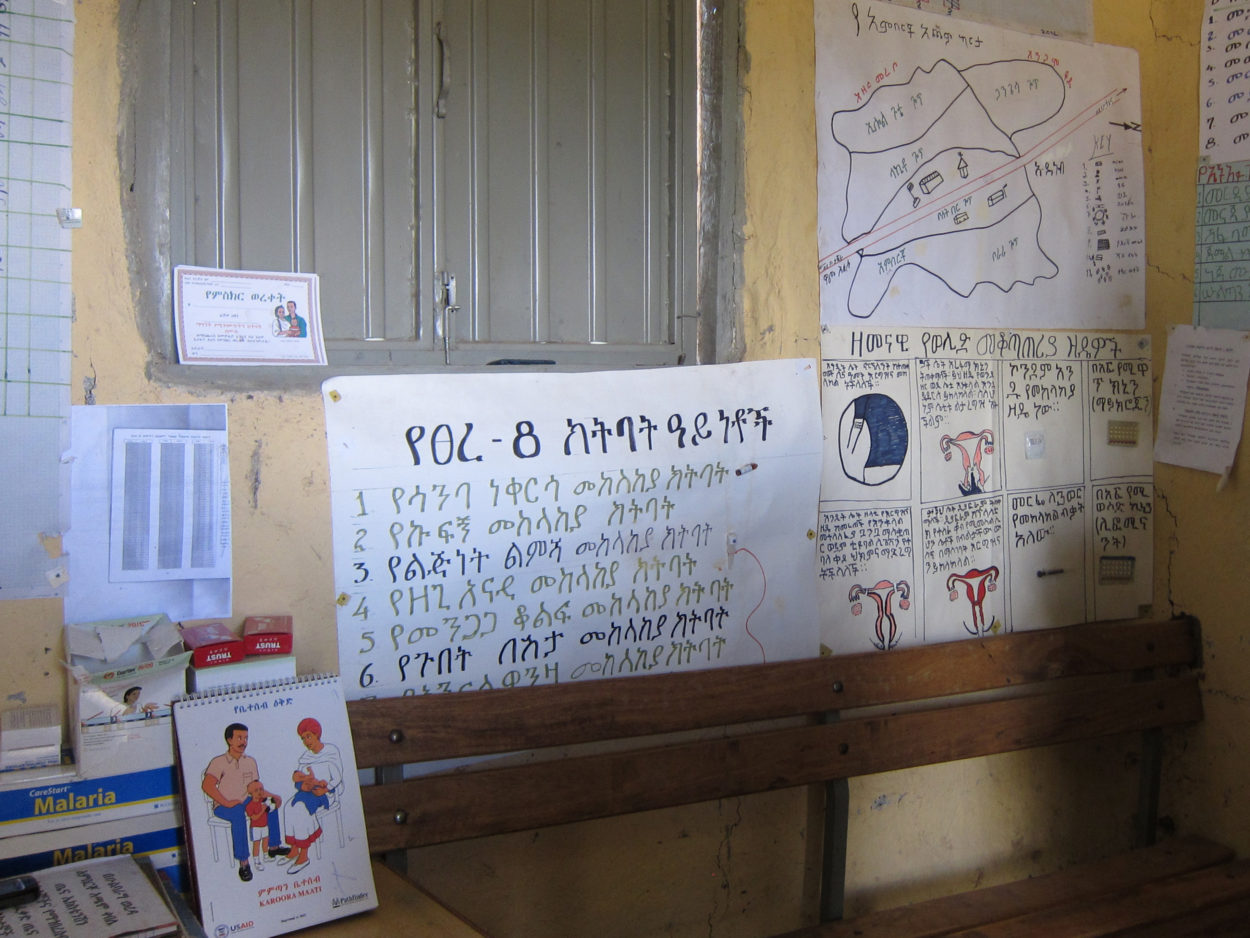Though originally from Ethiopia, I have spent most of my adult life abroad. Acronyms and terms such as HEWs, CHPs, Health Post and Health Centre were all new to me when I accepted the IDEAS Country Coordinator Research Fellow in Ethiopia position earlier this year. Since returning to Ethiopia, I have started an exciting personal journey of re-discovering Ethiopia and learning about its health system.
To find out which data were being collected and how this data informs decisions about healthcare, Bilal Avan (IDEAS Scientific Coordinator), Seifu (JaRco staff member) and I visited Primary Health Care Unit health facilities, an NGO and a private clinic in Dendi woreda (district) in Oromia region.
(NOTE: The trip was not without a few hair-raising moments: our driver had the counter intuitive reflex of speeding up at the sight of people and animals unexpectedly crossing the highway. We even hit a donkey, but to my surprise, it was still alive – albeit unwell – when we drove off. Rest assured, we swiftly changed drivers at the next opportunity!)
How a woman’s health data flows through the Ethiopian Health System

Dendi woreda has a population of 193,338 people who are served by five Health Centres and 48 Health Posts. To meet the goal of one Health Centre for every 25,000 people, woreda officials are constructing three more Health Centres. I met with welcoming health officials, professionals and workers who helped paint a picture of how a woman may use the PHCU and what would happen to her data:
A woman in a rural Ethiopian village learns she is pregnant. She tells all her family and friends. Word spreads and soon the local community health promoter (CHP – first acronym learned!) pays a visit to discuss the importance of antenatal care for her health and that of her unborn baby, suggesting a visit to the nearby Health Post. Wanting to make sure her baby is born healthy she heeds their advice and pays the Health Post a visit. Here she meets the Health Extension Worker (HEW – 2nd!) who registers the woman in the antenatal care register; a log book that tracks women through their pregnancy to ensure they receive all the care they need at the right stage. She is given an HIV test, which is also recorded.
Fast forward a few weeks to when the HEW is preparing the monthly report for the woreda health officer and our woman is one of 30 women that month who have come in for antenatal care. This information is sent on to the woreda, who compile all the reports from all the Health Posts and send it up the chain to the regional, zonal and eventually national health office. This office uses the data to produce national health statistics on uptake of antenatal care. Policy makers use this information alongside other national health statistics to make strategic decisions such as: Should we spend more on antenatal care? Do we need to improve antenatal care services?
Using data for decision making: lack of support at lower levels
I learned 2 really positive things about the health system data collection:
- Standardised data is regularly captured;
- This information is efficiently fed upstream from the small, rural health posts to the Regional, Zonal and eventually National Health Offices.
However, there are unnecessary limitations on the use of this data, which many of the Ethiopian health officials I met agreed with. While the national health office uses the statistics to monitor and act on national trends for decision making, there is little support at the lower levels of the health system for analysis. This presents challenges for the use of data for local decision making.
When visiting the Dendi Woreda Health Centre I was shown the record room; a dark office covered in bright pink and blue patient record folders immaculately arranged over several rows of shelves (picture). When I asked what was done with all the information in this room, it was clear that staff were unaware how it could be used to help them improve the services they offer.
Opportunity to use data on private sector and NGOs
Although my visit to the private health clinic made it clear there was little interaction with the woreda health office, I did find out that all private health facilities have to be accredited by the woreda administration. This is a unique opportunity that woredas could harness allowing them to regulate and collect data on all health services provided, rather than just those of the government.
Similarly, after meeting Save the Children US, it was clear that most of the NGO’s outputs are captured within the government’s Health Management Information System (HMIS). The HMIS provides a good opportunity to capture information about health services offered outside of the government health system.
What next? Harnessing enthusiasm to consolidate and make better use of health data
During my visits, I discussed the idea of using the data captured on the governmental health system, and potentially private sector and NGO health services, not only at national level but also at woreda level to inform woreda, zonal, regional and national level health policy decisions.
For IDEAS, capturing all this information will help us address one of our research questions: whether maternal and newborn health innovations have been scaled up across Ethiopia. Excitingly, I was struck by the receptiveness and enthusiasm of this idea from officials at the federal ministry all the way to the HEWs at the rural Health Posts. Thanks to this receptiveness I believe there is a good opportunity for the IDEAS project to work with the Ethiopian Ministry of Health to do just this.

